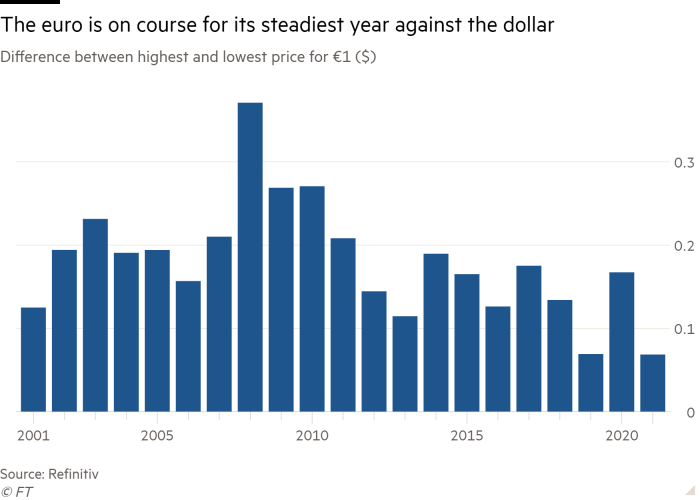Central banks’ efforts to steady the global economy since the start of the pandemic have lulled the $6.6tn a day foreign currency market into one of its sleepiest periods on record.
As the economic recovery began to take hold this spring and summer, stock markets across the globe rushed higher and government bond prices swung around in anticipation of the direction of monetary policy. Meanwhile, prices in the foreign exchange market moved very little and trading volume fell to multi-month lows. The exchange rate between the US dollar and the euro has this year traded in the narrowest range on record.
That is because central banks globally have moved more or less in lockstep since the start of the pandemic, creating very few chances for currencies to diverge in ways that create opportunities for profit. Even Monday’s tumult in markets sparked by the crisis at the Chinese developer Evergrande barely shook foreign exchange from its slumber, with major currencies sticking to their recent ranges.
“The foreign exchange market is exciting when you have central banks moving in different directions, when you have policy divergence. At the moment, all central banks are holding policy rates near zero at least across developed markets,” said Sam Lynton-Brown, head of developed markets strategy at BNP Paribas.

Divergence between currencies has also diminished because Covid-era central bank policy has become such a dominant driver of prices, nudging other typically market-moving factors aside. Interest rates are always paramount for currencies, but the global response to the pandemic has meant that national events, like the German elections, do not have the same capacity to move markets that they once did, said Shahab Jalinoos, global head of foreign exchange strategy at Credit Suisse.
Trading volume in the foreign exchange futures and options market dropped dramatically in August to the lowest since April 2020, according to CME data. And that is not purely a summer slowdown story: it was the slowest August since 2009. More broadly, average daily trading volume for the year is also the lowest it has been since 2009.

In developed-world currencies, recent excitement has been largely confined to Australia and New Zealand, two economies with central banks that are much closer to raising interest rates than their peers.
Investors are positioned for more of the same. Measures of expected volatility in currency markets have been steadily sinking since they exploded higher at the start of the pandemic. Three-month implied volatility for the euro against the dollar — a widely-tracked gauge of expected volatility in the world’s most heavily-traded currency pair based on options prices — sank to its lowest level of the year in mid-September, and is closing in on its record trough from early 2020. Similar measures for sterling and yen against the dollar are also close to all-time lows.
The period of calm has been bad news for investors who seek to profit from long-lasting trends or periods of volatility in exchange rates. Macro hedge funds, which bet on moves in bonds, currencies and commodities, have struggled this year even during a renaissance for the broader industry. Macro funds trading currencies are down 1.4 per cent this year to the end of August, according to data group HFR, while hedge funds as a whole are sitting on year-to-date gains of 10 per cent.
Once central banks signal they are prepared to change interest rate policy, this lull in forex could evaporate. “Given the number of issues markets will be dealing with over the coming year — high inflation, central bank rate hikes, tax increases, geopolitical tensions — we doubt foreign exchange volatility will remain depressed for very long,” said Zach Pandl, co-head of foreign exchange strategy at Goldman Sachs.
But still, the coming interest rate policy changes, when they do come, may be smaller than in the past given the sheer scale of debt taken on during the pandemic, said Ulrich Leuchtmann, head of foreign exchange research at Commerzbank.
“We get very worked up about whether the Fed will initiate its lift-off at the end of 2022 or in early or mid-2023 after all. And we disagree about whether the ECB will follow suit in 2024 or in 2025 . . . But to be honest this uncertainty is quite small in comparison to what used to be at stake. All that is a long way off yet,” said Leuchtmann.
Additional reporting by Laurence Fletcher and Eva Szalay in London
"exchange" - Google News
September 21, 2021 at 05:37PM
https://ift.tt/3nTHxaQ
Central bank sync puts foreign exchange market to sleep - Financial Times
"exchange" - Google News
https://ift.tt/3c55nbe
https://ift.tt/3b2gZKy
Exchange
Bagikan Berita Ini















0 Response to "Central bank sync puts foreign exchange market to sleep - Financial Times"
Post a Comment